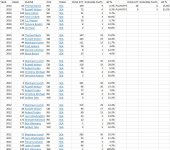Seymour":rg0u5o0e said:
I'll have to agree with Anthony. The only way to determine who is not pulling their weight, is to figure in money spent. When you are robbing Peter to pay Paul and Peter is always playing somewhere on offense, then that has to be accounted for.
Yep, and that's something that can be done! To do so you need to look ar proporational offensive and defensive spending per year. You can do that by attributing percentage of defensive spending from offensive and defensive total spending.
For each year, this is the percentage of offensive and defensive spending spent on the DEFENSE:
2013: 42.7
2014: 54.2
2015: 57.5
2016 58.6
This all comes from OTC, only going back to 2013 because they don't have spending for 2012.
From there you can get to OVER/UNDER performance by spending from JTB's table. The math is pretty simple. For 2013 you'd expect the defense to over-perform on expecations more than 42.7% of the time, and the offense to over-perform on expectations more than 57.3% of the time. We can just use JTB's +1/-1 System to do that too.
FROM THAT:
2013: Offense -1 (7 percentage points below expecations), Defense + 1 (37.5 percentage points above expectations
2014: Offense +1 (3.5 percentage points above expectations. Defense + 1 (10.3 percentage points above expectations)
2015: Offense -1 (2 percentage points below expectations), Defense +1 (11 percentage points above expectations)
2015: Offense +1 (6.8 percentage points above expectations), Defense -1 (21.4 percentage points below expectations)
From that using our +/- system we can say that the offense performs average to proportional spending expectations (2/4 years), and the defense peforms above average to proporational spending expectations (3/4 years).
That washes out the size of the differentials though, so let's just add up those differentials for each year and then divide by four to get a typical year:
In total, from 2013 to 2016 the Seahawks offense outperforms their proportional spending expectations by 1/3 of 1 percentage point per year, and the Seahawks defense outperforms their proportional spending expectations by 7.7 percentage points per year.
In conclusion, from 2013-2016 the Hawks not only leaned on their defense more than their offense, but they also got BETTER proportional monetary value from their defense than their offense:
:2thumbs:

